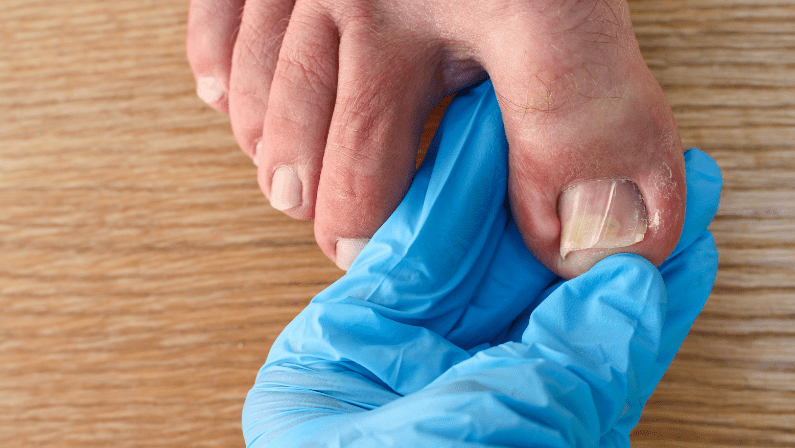
At AC Podiatry, we pride ourselves on delivering gentle yet effective foot care solutions to our patients in metropolitan Adelaide. Our patient-first approach ensures that you receive the most appropriate and comfortable treatment for your foot concerns. Today, we’re diving deep into a common yet often misunderstood condition: ingrown toenails (IGTNs). This comprehensive guide will help you understand, prevent, and manage IGTNs with expert insights from our podiatry team.
What are Ingrown Toenails?
Ingrown toenails occur when the sides or edges of a toenail grow into the surrounding skin, causing discomfort and potential complications. While this condition can affect any toe, it most commonly impacts the big toenail. Understanding the nature of IGTNs is the first step in effectively managing and preventing them.
Recognising the Symptoms
Identifying an ingrown toenail early can make a significant difference in treatment outcomes. Here are the key symptoms to watch for:
Pain and Tenderness
You may experience discomfort along the edge of the toenail, particularly when pressure is applied. This pain can range from mild to severe, depending on the extent of the ingrowth.
Swelling and Redness
The skin around the affected nail may become swollen and red, indicating inflammation in the area.
Infection Signs
If left untreated, an ingrown toenail can lead to infection. Look out for the formation of pus or drainage from the affected area.
Difficulty Walking or Wearing Shoes
As the condition progresses, you might find it increasingly uncomfortable to walk or wear shoes, impacting your daily activities.
Predisposing Factors: Understanding the Risks
Several factors can increase your likelihood of developing ingrown toenails. By understanding these risk factors, you can take proactive steps to prevent IGTNs:
Poor Nail Cutting Technique
Cutting nails too short or rounding the edges can encourage the nail to grow into the surrounding skin.
Ill-Fitting Footwear
Shoes that are too tight or narrow in the toe box can crowd your toes, putting pressure on the nails and encouraging ingrowth.
Trauma to the Nail
Injuries to the toenail, such as dropping something heavy on your foot, can alter nail growth patterns.
Genetic Predisposition
Some people may have a family history of IGTNs, suggesting a genetic component to the condition.
Other Nail Pathologies
Conditions like fungal infections can change the shape and structure of the nail, increasing the risk of ingrowth.
Prevention Strategies: Keeping IGTNs at Bay
At AC Podiatry, we believe that prevention is always better than cure. Here are some expert tips to help you avoid ingrown toenails:
Proper Nail Trimming
Cut your toenails straight across and avoid rounding the edges. Use proper nail clippers and avoid cutting nails too short.
Choose Appropriate Footwear
Opt for shoes with a wide toe box to prevent crowding of the toes. This allows your nails to grow naturally without pressure from tight shoes.
Protect Your Feet
Wear protective footwear in situations where your toes might be at risk of injury.
Maintain Good Foot Hygiene
Keep your feet clean and dry to prevent infections that could complicate an ingrown toenail.
Regular Podiatry Check-ups
Schedule regular visits to AC Podiatry for professional nail care and early detection of potential issues.
Treatment Options: AC Podiatry’s Approach
If you suspect you have an ingrown toenail, it’s crucial to seek professional care. At AC Podiatry, we offer a range of treatment options tailored to your specific needs:
Conservative Nail Edge Removal
For mild cases, our podiatrists can carefully remove the ingrown edge of the nail to provide immediate relief. This procedure is usually quick and minimally invasive.
Minimally Invasive Surgery
In more severe or recurring cases, a minor surgical procedure might be necessary. Our skilled podiatrists can perform this under local anaesthesia, ensuring your comfort throughout the process.
Onyfix Treatment
AC Podiatry is proud to offer the innovative Onyfix treatment for ingrown toenails. This specialized podiatry treatment involves applying a hardened composite material to the nail, which is then cured by an LED light. The Onyfix acts like a brace on the nail plate, guiding the nail to grow correctly from base to tip. This treatment helps reshape the nail’s growth pathway, effectively preventing future ingrowth.
The Onyfix Advantage:
- Non-invasive and painless application
- Allows for natural nail growth while correcting the ingrown tendency
- Suitable for various nail conditions, including IGTNs and involuted nails
- Can be an excellent alternative to surgery in many cases
Post-Treatment Care and Follow-Up
After your treatment at AC Podiatry, we’ll provide you with detailed aftercare instructions to ensure optimal healing and prevent recurrence. This may include:
- Proper wound care techniques
- Recommendations for appropriate footwear
- Guidelines for nail trimming and foot hygiene
- Follow-up appointments to monitor your progress
We’re committed to your long-term foot health, and our team will be there to support you every step of the way.
Your Path to Healthy Feet: Overcoming Ingrown Toenails
Ingrown toenails can be painful and disruptive, but with the right care and prevention strategies, you can keep your toes healthy and comfortable. At AC Podiatry, we combine our expertise with cutting-edge treatments like Onyfix to provide you with the best possible care for ingrown toenails and other foot concerns.
Don’t let ingrown toenails hold you back. If you’re experiencing symptoms or want to learn more about preventing IGTNs, schedule an appointment with AC Podiatry today. Our team of experienced podiatrists is here to help you achieve optimal foot health and get you back on your feet, pain-free!
